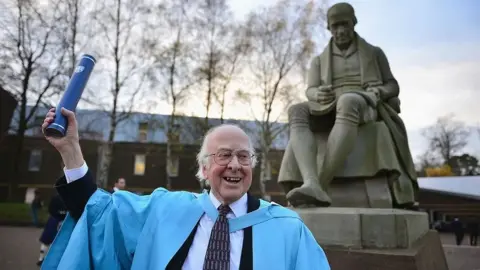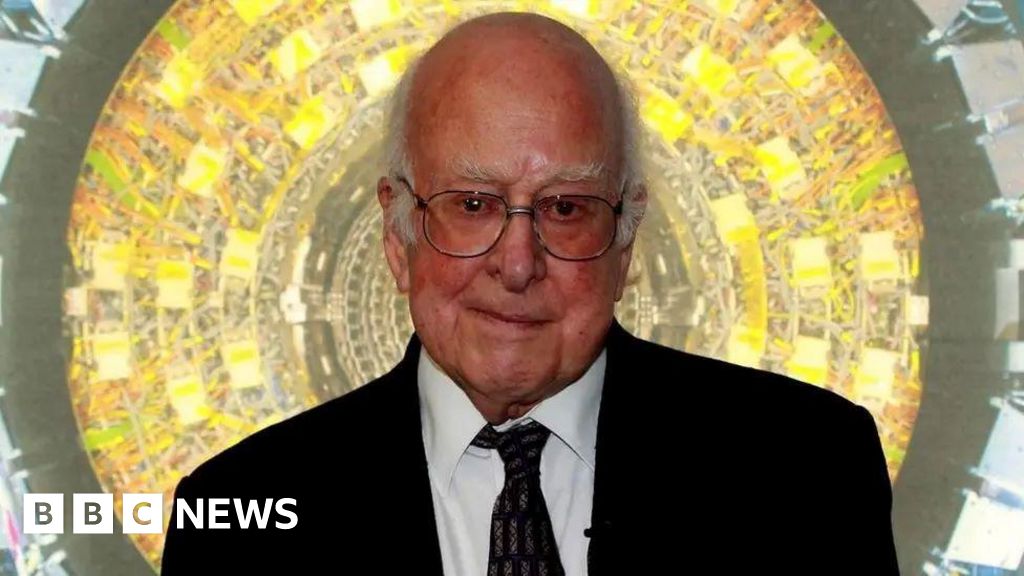 PA
PA
Prof Higgs was a researcher at Edinburgh University in 1964 when he predicted the existence of a new particle, also dubbed the “God particle”
The late Prof Peter Higgs has gifted his Nobel Prize medal to the university where he proposed a groundbreaking idea that would change scientists’ understanding of the universe.
Prof Higgs was a researcher at Edinburgh University in 1964 when he predicted the existence of a new particle, also dubbed the “God particle”, which is now seen as fundamental to the creation of the universe.
The particle, known as the Higgs boson, would not be confirmed for 50 years, with experiments at the Large Hadron Collider at Cern, the European Organisation for Nuclear Research, finally confirming his theory in 2012.
He was jointly awarded the Nobel Prize in Physics with Francois Englert in 2013.
 Open
Open
Peter Higgs was born in Newcastle upon Tyne in 1929
Edinburgh University said Prof Higgs left the medal to the institution in his will, following his death last April at the age of 94.
Prof Sir Peter Mathieson, principal and vice-chancellor of the university, said: “This generous gift will ensure that Peter Higgs’s extraordinary contributions to science will continue to inspire generations of students and researchers.
“We are profoundly honoured to have been entrusted with his Nobel Prize medal, an object of immense historical significance and a lasting emblem of his legacy.”
The medal will be preserved by the university’s centre for research collections and will be displayed at events and exhibitions, including the upcoming Higgs Lecture in 2026.
 Getty Images
Getty Images
Peter Higgs spent much of his life in Edinburgh
Prof Neil Turok, Higgs chairman of theoretical physics at the university, told BBC Radio’s Good Morning Scotland programme what it was like to work with his late colleague.
“He was a very unusual person and is very warmly remembered in the physics department,” he said.
“He was a very shy and private man. A very unlikely figure to discover what is one of the most important foundations of our descriptions of the laws of nature.”
He said Prof Higgs made his discovery in a “very unexpected way” in 1964.
“He put various ideas together, which has been around, but he finally saw how the jigsaw puzzle worked,” he said.
“He wrote a very short paper, just one-and-a-half pages, many people thought it was ridiculous, and it took a long time for the idea to be accepted.”
The theory was proved 50 years later with the Large Hadron Collider.
 Cern
Cern
Cern’s Large Hadron Collider Atlas detector under construction in Geneva
Prof Turok added: “What it shows though is something about nothing in a sense. Before Peter Higgs we thought of the vacuum as being empty and what he discovered is actually the vacuum is full of stuff. It’s like the sea.”
He said Edinburgh encouraged free thinking and independence of mind, which he thought suited Prof Higgs “perfectly”.
“It allowed him a lot of space to be adventurous, and he was a very adventurous mind but an incredibly shy person who hated attention,” he said.
“He hated the name the god particle, he thought that was the result of strictly logical deduction.
“He was like a very recluse would-be Scot.”
Prof Higgs was born in Newcastle upon Tyne in 1929 and joined Edinburgh University in 1960.


